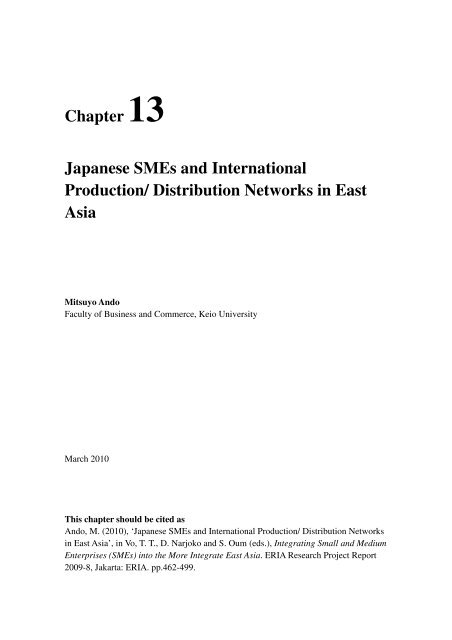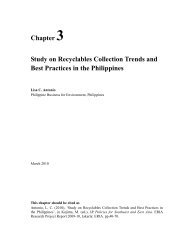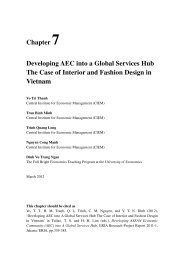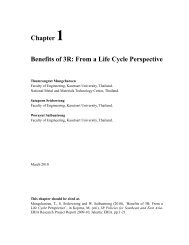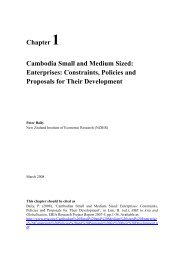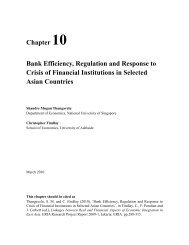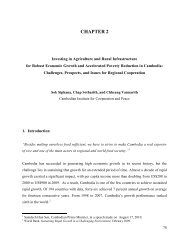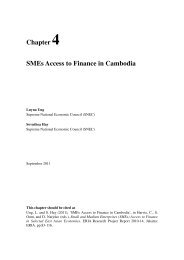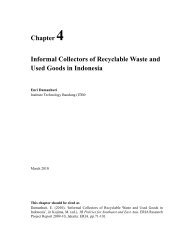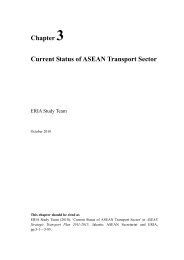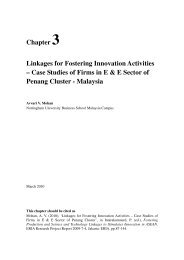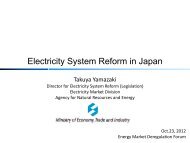Chapter 13 Japanese SMEs and International Production ... - ERIA
Chapter 13 Japanese SMEs and International Production ... - ERIA
Chapter 13 Japanese SMEs and International Production ... - ERIA
You also want an ePaper? Increase the reach of your titles
YUMPU automatically turns print PDFs into web optimized ePapers that Google loves.
<strong>Chapter</strong> <strong>13</strong><strong>Japanese</strong> <strong>SMEs</strong> <strong>and</strong> <strong>International</strong><strong>Production</strong>/ Distribution Networks in EastAsiaMitsuyo AndoFaculty of Business <strong>and</strong> Commerce, Keio UniversityMarch 2010This chapter should be cited asAndo, M. (2010), ‘<strong>Japanese</strong> <strong>SMEs</strong> <strong>and</strong> <strong>International</strong> <strong>Production</strong>/ Distribution Networksin East Asia’, in Vo, T. T., D. Narjoko <strong>and</strong> S. Oum (eds.), Integrating Small <strong>and</strong> MediumEnterprises (<strong>SMEs</strong>) into the More Integrate East Asia. <strong>ERIA</strong> Research Project Report2009-8, Jakarta: <strong>ERIA</strong>. pp.462-499.
CHAPTER <strong>13</strong><strong>Japanese</strong> <strong>SMEs</strong> <strong>and</strong> <strong>International</strong> <strong>Production</strong>/ DistributionNetworks in East AsiaMITSUYO ANDOFaculty of Business <strong>and</strong> Commerce, Keio UniversityThis paper attempts to investigate the mechanisms <strong>and</strong> features of the development ofinternational production/distribution networks in East Asia, focusing on <strong>Japanese</strong> <strong>SMEs</strong>, fromthe viewpoint of one of the major players in the regional production networks. Our empiricalanalysis using various surveys <strong>and</strong> micro data of <strong>Japanese</strong> firms demonstrates that active FDI invertical supply chains by <strong>SMEs</strong>, particularly in recent years, contributes to the formation ofagglomeration <strong>and</strong> industrial clusters <strong>and</strong> further development of the networks in East Asia. Ouranalysis also demonstrates that competitive <strong>SMEs</strong> are likely to exp<strong>and</strong> their operations bothdomestically <strong>and</strong> internationally, mainly in East Asia, by effectively being involved in theproduction/distribution networks in the region. To further develop international productionnetworks <strong>and</strong> to deeply involve <strong>SMEs</strong> in the networks, various facilitation measures are importantfor both hosting <strong>and</strong> investing countries. All the efforts from various different angles for bothsides should encourage <strong>SMEs</strong> to be an essential part of international production/distributionnetworks in East Asia, <strong>and</strong> thereby assist in strengthening their competitiveness by effectivelybeing involved in these networks.462
1. IntroductionIn East Asia, international production/distribution networks in manufacturing,particularly machinery industries, have been formed since the 1990s <strong>and</strong> furtherdeveloped in recent years. In conjunction with the development of production networksin the region, vertical back-<strong>and</strong>-forth transactions of parts <strong>and</strong> components havedramatically increased. Figure 1 presents the shares of machinery final goods <strong>and</strong>intermediate goods in total exports to/imports from the world for East Asian countries.The machinery trade, mainly machinery parts <strong>and</strong> components, as a share of total traderapidly exp<strong>and</strong>ed from the beginning of the 1990s to 2007 for both exports <strong>and</strong> imports,which suggests the existence of back-<strong>and</strong>-forth transactions <strong>and</strong> export-orientedoperations in East Asia. In addition, when countries are listed starting from the highestshare of machinery parts <strong>and</strong> components exports (non-East Asian countries are notpresented in Figure 1), most countries with the higher shares of machinery intermediategoods exports are East Asian countries in 2007 whereas they were developed countries atthe beginning of the 1990s. This indicates an increasing importance of machinery trade,particularly the machinery parts <strong>and</strong> components trade, in each economy in absolute <strong>and</strong>relative terms.463
%Figure 1. Machinery Final <strong>and</strong> Intermediate Goods as a Share of Total Trade inEast Asian Countries80706050Figure 1Machinery final <strong>and</strong> intermediate goods as a share of total trade inEast Asian countries403020100Japan90Malaysia90Singapore90HongKong93Korea90Thail<strong>and</strong>90China92Indonesia90Philippines07Export final goods Import final goodsExport parts <strong>and</strong> components Import parts <strong>and</strong> componentsData source: author's preparation, using UN Comtrade <strong>and</strong> World Trade Atlas.Notes: Machinery industries are HS84-92. The definition of machinery parts <strong>and</strong> components is basedon Ando <strong>and</strong> Kimura (2005) <strong>and</strong> the revised versions. Machinary final goods trade is obtained bydeleting machinery parts components from total machinery trade.Singapore07Taiwan07HongKong07Data source: Author’s preparation, using UN Comtrade <strong>and</strong> World Trade Atlas.Notes: Machinery industries are HS84-92. The definition of machinery parts <strong>and</strong> componentsis based on Ando <strong>and</strong> Kimura (2005) <strong>and</strong> the revised versions. Machinery final goodstrade is obtained by deleting machinery parts components from total machinery trade.Japan07Korea07Malaysia07Thail<strong>and</strong>07China07Indonesia07Such an expansion of back-<strong>and</strong>-forth transactions of machinery parts <strong>and</strong>components trade in East Asia is induced by intra-regional transactions. For instance,machinery intermediate goods trade in 2000 <strong>and</strong> 2007 for China, ASEAN4, NIEs4, <strong>and</strong>Japan demonstrates that intra-regional trade shares have increased for both exports <strong>and</strong>imports (except the case of China’s exports). These reached the range of 55 percent to 73percent for exports <strong>and</strong> from 63 percent to 82 percent for imports. Considering anexplosive expansion of trade values per se (from 525.7 billions US$ in 2000 to 1099.3billions US$ in 2007 for exports <strong>and</strong> from 418.0 billions US$ to 974.1 billions US$ for464
imports), including China’s exports (from 38.2 billions US$ to 250.5 billions US$), itimplies how rapidly <strong>and</strong> explosively back-<strong>and</strong>-forth transactions of East Asian machineryparts <strong>and</strong> components have exp<strong>and</strong>ed within the region.<strong>Japanese</strong> firms are some of the major players in the production networks of theregion. Since the late 1990's in particular, <strong>Japanese</strong> investment in East Asia hasaccelerated; as Figure 1 describes, an upward trend is vividly observed for directinvestment position of Japan (i.e. foreign direct investment (FDI) stock) in East Asiabased on the balance of payments statistics. Moreover, a predominant portion of theinvestment is in manufacturing sectors; the manufacturing share of <strong>Japanese</strong> directinvestment position for 2007 is 70 percent for East Asia as a whole, 75 percent for China,80 percent for the Association of Southeast Asian Nations (ASEAN) 4 including thePhilippines (75 percent), Indonesia (75 percent), Thail<strong>and</strong> (80 percent), <strong>and</strong> Malaysia (86percent), <strong>and</strong> 57 percent for Newly Industrializing Economies (NIEs) 4 including Taiwan(72 percent), Korea (61 percent), Singapore (58 percent), <strong>and</strong> Hong Kong (38 percent).465
Figure 2. <strong>Japanese</strong> Direct Investment Position in Asia160,000140,000120,000100 millions JPY100,00080,00060,00040,000AsiaChinaNIEs4ASEAN4Asia (mnfg)China (mnfg)NIEs4 (mnfg)ASEAN4 (mnfg)20,00001996 1997 1998 1999 2000 2001 2002 2003 2004 2005 2006 2007Data source: BOJ.Of course, <strong>Japanese</strong> small <strong>and</strong> medium sized enterprises (<strong>SMEs</strong>) are active ininvestment in East Asia, particularly in the manufacturing sector. This paper attempts toinvestigate the mechanism <strong>and</strong> features of the development of internationalproduction/distribution networks, focusing on patterns of exports <strong>and</strong> investment by<strong>SMEs</strong>, from the viewpoint of one of major investors in the region, <strong>and</strong> draw some policyimplications. For that purpose, this paper first attempt to uncover the features of overseasactivities of <strong>Japanese</strong> <strong>SMEs</strong> in terms of destinations of their exports as well as form ofexports, partners for direct exports, reasons/purposes of their investment, <strong>and</strong> so on,based on several surveys. Then, our paper analyzes patterns of FDI by <strong>Japanese</strong> <strong>SMEs</strong>,employing the micro data of <strong>Japanese</strong> firms <strong>and</strong> previous related studies, from theperspective of international production/distribution networks. We also briefly discusseconomic <strong>and</strong> policy environment for <strong>SMEs</strong>.466
The rest of the paper is organized as follows: the next section provides overviews of<strong>Japanese</strong> <strong>SMEs</strong> in terms of their export <strong>and</strong> investment patterns. Section 3 investigatesthe patterns of FDI by <strong>Japanese</strong> <strong>SMEs</strong>, based on the firm-level data. This section alsodiscusses patterns of globalizing activities of <strong>Japanese</strong> firms <strong>and</strong> their domesticoperations. Then, Section 4 briefly discusses economic <strong>and</strong> policy environment for<strong>SMEs</strong>, followed by conclusions in Section 5.2. Overviews of <strong>Japanese</strong> <strong>SMEs</strong> <strong>and</strong> Their Exports <strong>and</strong> InvestmentAbroadThis section discusses overviews of <strong>Japanese</strong> <strong>SMEs</strong> <strong>and</strong> their export <strong>and</strong> investmentpatterns, using 2009F/Y White Paper on Small <strong>and</strong> Medium Enterprises in Japan (SMEAgency, 2009a) <strong>and</strong> Basic Survey of Small <strong>and</strong> Medium Enterprises 2009 (SME Agency,2009b), which are published by the Small <strong>and</strong> Medium Enterprise Agency. Note thatsince we do not have an access to the raw data of Basic Survey, we can use onlyaggregated data. Moreover, the original source of some tables <strong>and</strong> figures in the WhitePaper is Mitsubishi UFJ Research <strong>and</strong> Consulting Co., Ltd. (2008). This survey wasconducted in March 2008 targeting 55,000 firms, <strong>and</strong> the return ratio was 15.7 percent.Therefore, the coverage of firms in this survey may not be so comprehensive as others.In Japan, the New Small <strong>and</strong> Medium Enterprise Basic Law defines <strong>SMEs</strong> as firmswith 300 or less regular workers or capital of no more than 300 millions JP yen, except for467
the wholesale, retail, <strong>and</strong> service sectors; regular workers of 100 or less for wholesale <strong>and</strong>services <strong>and</strong> 50 or less for retail or capital of no more than 100 millions for wholesales<strong>and</strong> 50 millions for retail <strong>and</strong> services. 1 Based on this definition, 99.7 percent of firms inJapan in all sectors other than primary sectors are classified into <strong>SMEs</strong>, <strong>and</strong> almost 70percent of regular workers in Japan belong to them (Table 1). In addition, over 10 percentof <strong>Japanese</strong> <strong>SMEs</strong> <strong>and</strong> over 20 percent of regular workers in <strong>Japanese</strong> <strong>SMEs</strong> are engagedin manufacturing sectors. Clearly, <strong>SMEs</strong> make up an essential part of manufacturingactivities in Japan.1 See Table A.1 for features of the SME Basic Law including the definition. In this section, <strong>SMEs</strong> aredefined as such unless specified <strong>and</strong> large firms are firms other than <strong>SMEs</strong>.468
Table 1. <strong>SMEs</strong> <strong>and</strong> Large Firms in Japan, 2006Table 1 <strong>SMEs</strong> <strong>and</strong> large firms in Japan, 2006All sized firms <strong>SMEs</strong>: the number of firms <strong>SMEs</strong>: the number of regular workersIndustryThe numberThe numberof regular(%by(%byof firms(% in total)workersindustry)industry)(% in total)Mining 2,086 25,189 2,082 99.8 0.0 22,062 87.6 0.1Construction 489,645 3,290,238 489,343 99.9 11.7 2,882,090 87.6 10.4Manufacturing 457,623 9,424,333 455,621 99.6 10.9 5,903,494 62.6 21.2Electricity, gas, <strong>and</strong> water supply 567 190,768 537 94.7 0.0 27,477 14.4 0.1Information <strong>and</strong> communication 35,052 1,426,491 33,814 96.5 0.8 666,888 46.8 2.4Transportation 77,403 2,594,245 77,<strong>13</strong>2 99.6 1.8 1,857,903 71.6 6.7Wholesale 233,846 3,328,161 231,755 99.1 5.5 2,322,118 69.8 8.3Retail 880,575 6,610,931 877,875 99.7 20.9 4,286,343 64.8 15.4Finance <strong>and</strong> insurance 30,256 1,010,855 29,985 99.1 0.7 170,470 16.9 0.6Real estates 285,812 794,7<strong>13</strong> 285,710 100.0 6.8 698,796 87.9 2.5Restaurants <strong>and</strong> lodgings 648,614 3,555,630 647,754 99.9 15.4 2,820,399 79.3 10.1Medical services 188,752 1,173,472 188,514 99.9 4.5 1,082,606 92.3 3.9Education services 115,934 544,038 115,803 99.9 2.8 458,300 84.2 1.6Multi services 3,718 8,395 3,717 100.0 0.1 8,246 98.2 0.0Other services 760,187 6,149,521 758,077 99.7 18.1 4,628,358 75.3 16.6Total (excl. primary sectors) 4,210,070 40,126,980 4,197,719 99.7 100.0 27,835,550 69.4 100.0Data source: author's preparation, based on SME Agency (2009a).Note: The number of firms here includes the number of companies <strong>and</strong> individual establishments.Data source: Author’s preparation, based on SME Agency (2009a).Note: The number of firms here includes the number of companies <strong>and</strong> individual establishments.469
How are these <strong>SMEs</strong> involved in foreign markets through export <strong>and</strong> investmentactivities? Figure 3 presents destination shares of exports for three products: SME-typeproducts, large firm-type products, <strong>and</strong> common-type products. 2Close to 70 percent ofexports of SME-type products, which are produced mainly by <strong>SMEs</strong>, go to Asiancountries including China, Korea, ASEAN10, Hong Kong <strong>and</strong> Taiwan, <strong>and</strong> other parts ofAsia. Combined with the fact that the corresponding share for large firm-type products isaround 40 percent, it suggests that <strong>Japanese</strong> <strong>SMEs</strong>, in particular, are closely associatedwith Asian economies as suppliers of intermediate goods <strong>and</strong>/or final goods.Figure 3. Destination Shares of Exports for 3 Types of Products in 2007100%in 2007Others90%80%Western Europe70%60%50%40%30%20%10%0%SME-typeCommon-type Large firm-typeNorth AmericaOther AsiaHongKong&TaiwanASEAN10KoreaChinaData source: author’s preparation, based on SME Agency (2009a).Note: SME-type products (large firm-type products) are defined here as those with 70 percent or moreof total sales by <strong>SMEs</strong> (large firms) in 2005. Common-type products are those not classifiedinto either SME-type or large firm-type.2 SME-type products (large firm- type products) are defined here as those with 70 percent or more oftotal sales by <strong>SMEs</strong> (large firms) in 2005. Common-type products are those not classified into eitherSME-type or large firm-type.470
<strong>Japanese</strong> <strong>SMEs</strong> do not necessarily export their products directly. In Figure 4, theforms of exports are distinguished among direct exports, indirect exports, <strong>and</strong> exportsthrough firms in supply chains; direct exports are those that undertake customs clearancewith the firm’s own name, <strong>and</strong> indirect exports are those conducted by identifieddomestic trading companies, wholesalers, or export agencies. When products are notexported in any of these three forms, they are classified as the case of “never exported” inthis figure. Figure 4 shows that 15 percent of <strong>SMEs</strong> in the survey export their productsdirectly <strong>and</strong> 18 percent export indirectly, though they are much lower than in the case oflarge firms which have corresponding shares of 47 percent <strong>and</strong> 29 percent, respectively. 3Moreover, one-third of <strong>SMEs</strong> supply their products to firms in their downstream who usethose products to produce goods to be exported. As a consequence, almost half of <strong>SMEs</strong>in the survey are somehow involved in export activities (see the portion of “neverexported”), <strong>and</strong> a significant portion of products produced by <strong>SMEs</strong> are likely to be soldto the market abroad in either way, directly, indirectly, or through business partners insupply chains.3 Multiple answers are allowed here.471
Figure 4. Form of Exports by <strong>SMEs</strong> <strong>and</strong> Large Firms%60Figure 4 Form of exports by <strong>SMEs</strong> <strong>and</strong> large firms50403020<strong>SMEs</strong>Largefirms100Direct exportsIndirect exports Exports throughfirms in supplychainNever exportedData source: SME Agency (2009a) (Original data source: Mitsubishi UFJ Research <strong>and</strong> ConsultingCo., Ltd. (2008)).Who are the partners of direct exports undertaken by <strong>Japanese</strong> <strong>SMEs</strong>? For largefirms the major partners are local manufactures (52 percent), <strong>Japanese</strong> manufactures (45percent), <strong>and</strong> local wholesalers (35 percent or 30 percent) (Table 2). On the other h<strong>and</strong>,the major partners for <strong>SMEs</strong> are local manufactures (42 percent) <strong>and</strong> local small <strong>and</strong>median sized wholesalers (30 percent), followed by <strong>Japanese</strong> manufactures in the localmarket (26 percent). This indicates that compared with large firms, <strong>Japanese</strong> <strong>SMEs</strong> aremore likely to sell their products to indigenous firms including indigenous <strong>SMEs</strong>, ratherthan to <strong>Japanese</strong> firms in the local markets.472
Table 2. Partners of Direct Exports<strong>SMEs</strong> Large firmsLocal Major wholesalers 11% 30%Small <strong>and</strong> medium sized wholesalers 30% 35%Retailers 12% 15%Manufactures 43% 52%Other traders 9% 15%<strong>Japanese</strong> Major wholesalers 5% 16%Small <strong>and</strong> medium sized wholesalers 7% 10%Retailers 1% 5%Manufactures 26% 45%Other traders 3% 4%Others 8% 17%Data source: SME Agency (2009a) (Original data Source: Mitsubishi UFJ Research <strong>and</strong> ConsultingCo., Ltd. (2008)).Notes: Multiple answers are allowed. Firms with direct exports only.Foreign exposure through investment by <strong>SMEs</strong> is also deeply associated with Asiancountries, as is the case of exports. Table 3 demonstrates that most foreign affiliates of<strong>SMEs</strong> are located in Asia. In addition, over 60 percent of their majority owned affiliatesin Asia are engaged in manufacturing activities, mainly in machinery sectors.473
Table 3. The Number of <strong>SMEs</strong> with Foreign Operations by Industry, 2007FYTable 3 The number of <strong>SMEs</strong> with foreign operations by industry, 2007FYThe numberof firmsThe numberof firmswith foreignoperationsTotal Asia Total Asia Total Asia(% in(% in(% in(% inIndustrytotal)total)total)total)Total 3,756,685 15,252 100.0 9,757 7,743 100.0 10,973 8,874 100.0 5,807 4,327 100.0Manufacturing total 431,840 6,673 43.7 5,665 4,737 61.2 5,436 4,939 55.7 1,359 1,100 25.4Food 39,922 448 2.9 152 123 1.6 875 865 9.7 <strong>13</strong>7 115 2.7Beverages, tabbaco, feed 5,873 39 0.3 32 31 0.4 6 6 0.1 n.a.Textiles (excluding textile products) 21,550 165 1.1 110 110 1.4 83 83 0.9 31 31 0.7Clothing, textile products 29,252 480 3.1 457 457 5.9 415 415 4.7 104 104 2.4Lumber, wood products (excluding furniture) <strong>13</strong>,990 35 0.2 42 40 0.5 4 3 0.0 n.a.Furniture, furnishing 23,937 45 0.3 21 17 0.2 31 31 0.3 28 28 0.6Pulp, paper, processed paper products 9,910 57 0.4 11 9 0.1 46 24 0.3 n.a.Printing or other related business 33,890 171 1.1 215 177 2.3 128 128 1.4 43 34 0.8Chemicals 4,776 355 2.3 411 372 4.8 406 406 4.6 92 92 2.1Petroleum <strong>and</strong> coal products 424 3 0.0 3 3 0.0 n.a. n.a.Plastic products (excluding those listed elsewhere) 18,602 753 4.9 534 218 2.8 1,465 1,254 14.1 11 9 0.2Rubber products 4,980 91 0.6 157 147 1.9 12 5 0.1 19 12 0.3Hides <strong>and</strong> furs 6,224 91 0.6 21 21 0.3 175 175 2.0Ceramics, earthenware 17,340 190 1.2 104 95 1.2 <strong>13</strong>6 <strong>13</strong>6 1.5 58 53 1.2Iron <strong>and</strong> steel 5,039 80 0.5 100 73 0.9 20 20 0.2 n.a.Non-ferrous metals 3,670 141 0.9 122 122 1.6 36 36 0.4 8 6 0.1Metal products 58,432 679 4.4 561 561 7.2 326 326 3.7 n.a.General machinery 54,711 1,102 7.2 989 855 11.0 552 410 4.6 149 140 3.2Electrical machinery 15,009 358 2.3 238 238 3.1 172 123 1.4 61 7 0.2Information-communications equipment 2,995 142 0.9 156 <strong>13</strong>8 1.8 62 59 0.7 6 3 0.1Electronic parts, devices 8,414 381 2.5 354 318 4.1 161 153 1.7 366 286 6.6Transportation machinery 18,160 497 3.3 543 356 4.6 227 186 2.1 142 92 2.1Precision machinery 8,305 <strong>13</strong>1 0.9 106 62 0.8 24 21 0.2 37 22 0.5Other manufacturing industries 26,436 240 1.6 227 196 2.5 72 72 0.8 65 65 1.5Data source: author's calculation, based on SME Agency (2009b).Note: The number of firms here includes the number of companies <strong>and</strong> private establishments.474The number ofmajority-owenedforeign affiliatesThe number of minorityowenedforeign affiliatesThe number of foreignestablishments/offices/factories
The major reason for their FDI with a highest share is “reduction of production costsdue to inexpensive labor forces etc” (52 percent), followed by “local procurement ofproducts, parts, <strong>and</strong> raw materials” (47 percent) <strong>and</strong> “market expansion <strong>and</strong> salespromotion in the local market” (44 percent), for <strong>SMEs</strong>, while it is “market expansion <strong>and</strong>sales promotion in the local market” (69 percent) for large firms (Table 4) 4 . Moreover,although we cannot identify whether it is due to Keiretsu relationship or not, a quarter of<strong>SMEs</strong> with foreign operations in the survey go abroad to follow business partners’ entryinto the foreign market, <strong>and</strong> 17 percent of those <strong>SMEs</strong> enter the foreign market accordingto the request of their business partners. These suggest that <strong>SMEs</strong> invest in foreignmarkets, mostly in Asia, in order to engage in manufacturing activities, contributing tothe dense supporting industries in the production networks.Table 4. Reasons for Foreign Operations<strong>SMEs</strong> Large firmsMarket expansion <strong>and</strong> sales promotion in the local market 44% 69%Local procurement of products, parts, <strong>and</strong> raw materials 47% 33%Gathering local information 21% 26%Reduction of production costs due to inexpensive labor forces etc 52% 45%Following to the business partners entering the foreign market 25% 31%Request of entry to the foreign market from the business partners 17% 17%Securing excellent human resources 6% 4%Strengthening networks with local governments 1% 2%Others 2% 3%Data Source: SME Agency (2009a) (Original Data Source: Mitsubishi UFJ Research <strong>and</strong> ConsultingCo., Ltd. (2008).Note: Firms with foreign operations only.Table 5 demonstrates what <strong>SMEs</strong> expect in order to exp<strong>and</strong> into foreign markets to4 Multiple answers seem to be applied, though it is not described in the original source.475
sell their products as well as their FDI. According to this table, the following factorsincluding “reduction of tariffs on parts <strong>and</strong> final products” (52 percent), “strengtheningprotection of IPRs such as a crackdown on counterfeit goods” (43 percent), “ensuringsecurity <strong>and</strong> safety” (41 percent), <strong>and</strong> “speedy procedures for trade <strong>and</strong> investment” (39percent) seem to be effective measures for promoting foreign market expansion <strong>and</strong> FDIfor <strong>SMEs</strong>.Table 5. Effective Measures to Promote Foreign Market Expansion <strong>and</strong> FDI for<strong>SMEs</strong>Reduction of tariffs on parts <strong>and</strong> final products 52%Liberalization of services sectors <strong>and</strong> transparency of laws <strong>and</strong> regulations 20%Strengthening protection of IPRs such as crackdown on counterfeit goods 43%Improvement of harmonization <strong>and</strong> transparency of st<strong>and</strong>ards 20%Non-discriminate <strong>and</strong> fair system of hosting investment 8%Speedy procedures for trade <strong>and</strong> investment 39%Avoiding dual taxation 23%Avoiding dual social insurance 8%Facilitation of procedures to obtain visa 11%Development of infrastructure such as electricity, water supply, <strong>and</strong> roads 21%Industrial cooperation through human resource development etc 17%Ensuring security <strong>and</strong> safety 41%Data Source: SME Agency (2009).(Original Data Source: Mitsubishi UFJ Research <strong>and</strong> ConsultingCo., Ltd. (2008).Note: Multiple answers are applied.Before moving to the next section, let us briefly review the voices of <strong>Japanese</strong>manufacturing firms on how they assess East Asia as a potential destination of their FDI<strong>and</strong> what they regard as impediments in such countries for their FDI, although this surveybasically covers both <strong>SMEs</strong> <strong>and</strong> large firms. The Japan Bank for <strong>International</strong>Cooperation (JBIC) annually conducts a questionnaire survey for <strong>Japanese</strong>476
manufacturing MNEs; one of the key questions of the survey is to list countries whichthey think are prospective destinations of their FDI in the short term (upcoming 3 years)<strong>and</strong> to summarize the reasons for their choice as well as the strong <strong>and</strong> weak points ofsuch countries. 5The results of the 2009 F/Y questionnaire survey show that China(selected by 353 firms out of 480) is by far the most important possible destination fortheir FDI, followed by other Asian countries; India (2 nd , 278 firms), Vietnam (3 rd , 149firms), Thail<strong>and</strong> (4 th , 110 firms), Indonesia (8 th , 52 firms), Korea (9 th , 31 firms), Malaysia(10 th , 26 firms), Taiwan (11 th , 21 firms), the Philippines (<strong>13</strong> th , 14 firms), <strong>and</strong> Singapore(18 th , 7 firms) (Table 6). 6 It implies that many of the top 20 countries, particularly the top10 countries, are East Asian countries.5 The 2009 F/Y questionnaire survey was conducted in July 2009 for <strong>Japanese</strong> firms with three ormore foreign affiliates including at least one manufacturing foreign affiliate, in which 625 firms out of1004 returned effective answers. The summarized report is available from the JBIC website,http://www.jbic.go.jp/ja/about/press/2009/1106-01/index.html.6 The corresponding countries for only <strong>SMEs</strong> with no more than 1 billions JP Yen are quite similar:China (1 st , 80 firms out of 123), India (2 nd , 67 firms), Vietnam (3 rd , 45 firms), Thail<strong>and</strong> (4 th , 38 firms),Indonesia (6 th , 18 firms), <strong>and</strong> Malaysia (9 th , 9 firms).477
Table 6. Strong <strong>and</strong> Weak Points of Prospective Destination Countries for <strong>Japanese</strong> Manufacturing FDITable 6 Strong <strong>and</strong> Weak Points of Prospective Destination Countries for <strong>Japanese</strong> Manufacturing FDIRankinga1 2 3 4 5 6 7 7 9 10Number of firms 353 278 149 110 103 95 65 52 31 26Country China India Vietnam Thail<strong>and</strong> Russia Brazil USA Indonesia Korea MalaysiaStrong pointsb348 275 149 103 95 95 64 50 30 26PercentHuman capital 10 19 22 10 1 2 11 6 <strong>13</strong> 15Inexpensive labor 44 39 58 42 8 15 - 46 - 39Cheap parts <strong>and</strong> components / raw materials 20 10 7 11 3 5 2 8 7 8To supply intermediate goods for assemblers 20 19 15 21 9 16 <strong>13</strong> 32 16 27Agglomeration/industrial clusters 16 3 2 17 3 3 14 10 26 8Risk diversion from other countries 1 5 19 10 1 1 - 6 - 8To export to Japan <strong>13</strong> 2 11 11 - - - 10 - 15To export to the third countries 17 7 15 27 2 8 - 26 - 19Advantage in local procurement 8 3 3 7 6 4 5 6 7 12Present market size 33 19 9 25 18 18 69 22 58 12Market potential 85 90 60 48 85 86 44 64 55 42Rate of returns of market 9 4 3 7 6 3 14 14 <strong>13</strong> 4R&D for the local market 3 1 2 4 - - 11 2 7 -Development of infrastructure 10 0 3 23 6 3 23 2 26 19Development of logistics services 2 0 1 10 - 1 14 2 7 4Investment incentives / deregulation measures 8 1 14 23 2 3 2 4 3 19Stable policies such as foreign investment 3 3 5 <strong>13</strong> - - 2 2 - 12Economic/social stability 4 4 11 9 5 5 27 4 23 27478
cWeak points 336 260 <strong>13</strong>6 104 99 88 60 48 31 24PercentUnderdevelopment of legal system 16 17 24 6 15 10 - <strong>13</strong> - 4Nontransparency in the legal system 56 29 31 6 33 22 - 27 - 4Complicated taxation system <strong>13</strong> 24 6 7 5 22 - 8 - 4Nontransparency in the implementation oftaxation system32 22 16 8 16 14 - 21 3 <strong>13</strong>Raised tax 21 8 6 11 3 2 7 10 7 8Restrictions/regulations for foreign capital 25 12 15 15 11 <strong>13</strong> - 6 7 4Complicated <strong>and</strong> nontransparentadministrative procedures for investment20 14 11 7 22 16 - 8 - 8Insufficient protection of IPRs 47 8 8 7 4 5 2 <strong>13</strong> 7 4Restrictions/regulations on exchange rates <strong>and</strong>overseas remittance38 <strong>13</strong> <strong>13</strong> 9 11 8 - 6 10 4Import restrictions <strong>and</strong> customs clearance 19 11 9 3 19 15 8 8 7 4Insufficient human capital for engineeringpositions7 10 20 16 11 10 <strong>13</strong> 25 7 29Insufficient human capital for managerialpositions21 16 29 30 <strong>13</strong> 15 23 27 3 25Rising labor costs in host country 56 17 27 27 12 11 5 27 23 21Local labor problems 18 20 14 8 5 <strong>13</strong> 73 15 3 4Harsh competition with other firms in thelocal market50 30 10 39 21 21 - 19 55 17Difficulty in collecting bill 28 7 4 4 12 3 - - - 8Difficulty in local financing 9 6 3 - 5 6 - 4 - 0Underdevelopment of indigenous supportingindustries4 12 18 2 6 5 - 10 - 4Instability of local currency/pricing 3 5 <strong>13</strong> 6 12 15 - 19 23 -Insufficient infrastructure 15 47 34 4 17 <strong>13</strong> - 35 - 4Instability of security <strong>and</strong> society <strong>13</strong> 30 7 28 26 28 - 42 - 4Insufficient information on the host country 2 20 15 4 25 23 - 10 - <strong>13</strong>a. The ranking is based on the number of <strong>Japanese</strong> manufacturing firms that chose the country as a prospective destination for their FDI in the short run.b. The figures to the right are the number of <strong>Japanese</strong> manufacturing firms that answered the question on strong points among those that chose the country as aprospective destination for their FDI.c. The figures to the right are the number of <strong>Japanese</strong> manufacturing firms that answered the question on weak points among those that chose the country as aprospective destination for their FDI.d. This JBIC 2009 F/Y questionnaire survey was conducted in July 2009 for <strong>Japanese</strong> manufacturing firms with three or more foreign affiliates including at leastone manufacturing foreign affiliate, in which 625 firms out of 1004 returned effective answers.e. Multiple listings of destination countries are allowed.Source: JBIC (2009).479
The reasons for their choices show that “market potential” <strong>and</strong> “inexpensive labor”are important conditions that attract incoming FDI in most of the East Asian countries.More interestingly, factors related to vertical production chains or intra-regional tradesuch as “to supply intermediate goods for assemblers”, “to export to the third countries”,“to export to Japan”, <strong>and</strong> “agglomeration/industrial clustering” are also listed by manyfirms for most of the countries. 7These imply that many <strong>Japanese</strong> manufacturing firmsinvolve vertical production activities <strong>and</strong> form industrial clusters in East Asia,contributing to the formation of the international production/distribution networks.Table 6 also presents what <strong>Japanese</strong> manufacturing firms view as weak points in eachprospective destination for FDI. Many firms cite issues such as insufficient humancapital for engineering/managerial positions, rising labor costs in host country, harshcompetition, non-transparency in the legal system <strong>and</strong> in the implementation of taxationsystem, underdevelopment of legal system, restrictions/regulations for foreign capital,insufficient infrastructure, instability of security <strong>and</strong> society, insufficient informationrelating to the host country, <strong>and</strong> other such conditions as weak points of destinationcountries. The survey confirms that the development of human capital <strong>and</strong> physicalinfrastructure, transparency in legal systems <strong>and</strong> their implementation, particularly oftax-related regulations, <strong>and</strong> improvement of labor-related issues are key for hosting FDI.This is consistent with the results from another survey on <strong>Japanese</strong> firms shown in TableA.2 in the Appendix, which clearly presents the importance of further investment7 For instance, “to supply intermediate goods for assemblers” is selected by the 20 percent of the firmsthat list China as a prospective destination for their FDI, 19 percent for India, 15 percent for Vietnam,21 percent for Thail<strong>and</strong>, 32 percent for Indonesia, <strong>and</strong> 27 percent for Malaysia.480
facilitation to activate the investment of <strong>Japanese</strong> firms.3. <strong>Japanese</strong> <strong>SMEs</strong> in <strong>International</strong> <strong>Production</strong>/Distribution Networksin East AsiaThis section investigates patterns of investment in East Asia by <strong>SMEs</strong> <strong>and</strong>globalizing patterns of <strong>Japanese</strong> firms including <strong>SMEs</strong>, with a particular emphasis onfirms investing in East Asia <strong>and</strong> international production/distribution networks. 8Theanalysis here is based on the firm-level statistics, which is conducted by the Ministry ofEconomy, Trade, <strong>and</strong> Industry (METI), Government of Japan: The Basic Survey ofBusiness Structure <strong>and</strong> Activity. This database provides detailed information on (parent)firms located in Japan as well as the number, industry, <strong>and</strong> regional location of theirforeign affiliates with not less than 20 percent <strong>Japanese</strong> ownership. 9The samples in thesurvey covers firms with more than 50 workers, capital of more than 30 million yen, <strong>and</strong>establishments in mining, manufacturing, wholesale/retail trade, or restaurants.Table 7 presents the number of <strong>SMEs</strong> with affiliates in East Asia/NorthAmerica/Europe <strong>and</strong> the number of affiliates in East Asia/North America/Europe by theindustry of parent firms <strong>and</strong> by the industry of affiliates. 10 In 2004, 4,590 out of 28,3408 This section is based on Ando <strong>and</strong> Kimura (2010).9 Note that the location of foreign affiliates is not identified on the country basis; the questionnairesfrom the 1997F/Y Basic Survey include only East Asia, North America, <strong>and</strong> Europe as regionalcategories.10 <strong>SMEs</strong> are here defined as firms with regular workers of less than 300 in this section.481
firms located in Japan (in the data set) have affiliates abroad, <strong>and</strong> 3,847 firms among thesehave affiliates in East Asia. When we focus only on <strong>SMEs</strong>, 1,948 out of 2,364 <strong>SMEs</strong> thathave affiliates abroad have affiliates in East Asia. That is, over 80 percent of <strong>Japanese</strong>firms going abroad, regardless of whether they are large firms or <strong>SMEs</strong>, have at least oneaffiliate in East Asia.Table 7. Sectoral Patterns of <strong>Japanese</strong> Parent <strong>SMEs</strong> <strong>and</strong> Their Affiliates in EastAsia for 2004Table 7 Sectoral patterns of <strong>Japanese</strong> parent <strong>SMEs</strong> <strong>and</strong> their affiliates in East Asia for 2004Industry ofparent firmNumberof parent<strong>SMEs</strong>Number of affiliates by the industry of parent firmsShare by the industry of affiliateManufacturingNonmanufacturing(%) (%) (machinery) (wholesales)(a) East AsiaManufacuturing 1,280 66% 1,962 62% 84% (39%) 16% (12%)-Machinery 534 27% 916 29% 82% (76%) 18% (14%)Non-manufacturing 668 34% 1,202 38% 35% (9%) 65% (55%)-Wholesales 528 27% 1,094 35% 36% (9%) 64% (60%)Total 1,948 100% 3,164 100% 65% (28%) 35% (28%)(b) North AmericaManufacuturing 367 60% 386 61% 55% (29%) 45% (33%)-Machinery 195 32% 222 35% 50% (47%) 50% (40%)Non-manufacturing 249 40% 246 39% 11% (6%) 89% (66%)-Wholesales 176 29% 197 31% <strong>13</strong>% (7%) 87% (78%)Total 616 100% 632 100% 38% (20%) 62% (46%)(c) EuropeManufacuturing 128 56% 158 56% 48% (17%) 52% (43%)-Machinery 64 28% 88 31% 34% (31%) 66% (56%)Non-manufacturing 101 44% 125 44% 18% (14%) 82% (63%)-Wholesales 81 35% 114 40% 20% (16%) 80% (68%)Total 229 100% 283 100% 35% (16%) 65% (52%)Data source: Ando <strong>and</strong> Kimura (2010).Note: The figures for "share" for manufacuring, machinery, non-manufacturing, <strong>and</strong>wholesales express the shares of manufacturing affiliates, machinery affiliates, nonmanufacturingaffiliates, <strong>and</strong> wholesales affiliates in total number of affiliates of <strong>SMEs</strong> ineach sectoral category.482
<strong>Japanese</strong> manufacturing parent firms, particularly machinery parent firms, are activeinvestors in East Asia; close to 70 percent of the <strong>Japanese</strong> <strong>SMEs</strong> with affiliates in EastAsia are in the manufacturing sector <strong>and</strong> over 40 percent of them are in machineryindustries. Moreover, <strong>Japanese</strong> manufacturing affiliates, regardless of the industries oftheir parent <strong>SMEs</strong>, account for 65 percent of the total <strong>Japanese</strong> affiliates in the region,while it is 38 percent for North America <strong>and</strong> 35 percent for Europe. Interestingly, theproportion of manufacturing affiliates in East Asia with parent <strong>SMEs</strong> (65 percent) ishigher than that of manufacturing affiliates in East Asia with all-sized parent firms (61percent). This statistic indicates that <strong>Japanese</strong> <strong>SMEs</strong> are more likely to be deeplyinvolved in manufacturing activities in East Asia.A parent firm often conducts various types of operations at the same time <strong>and</strong>establishes foreign affiliates in order to conduct a subset of those activities. <strong>Japanese</strong>manufacturing parent <strong>SMEs</strong> have 84 percent of their total affiliates in East Asia in themanufacturing sector, which is higher than the corresponding portion for all-sizedmanufacturing parent firms (73 percent). Such investment patterns by <strong>SMEs</strong> reflect atypical strategy for firms involved in manufacturing activities which are aimed atsupplying intermediate goods for other firms <strong>and</strong>/or for their own affiliates <strong>and</strong> forming acritical mass of industrial clusters in the manufacturing sector. <strong>Japanese</strong> manufacturingparent <strong>SMEs</strong> also have non-manufacturing affiliates in East Asia (16 percent of totalaffiliates of manufacturing firms), particularly in the wholesales sector (12 percent) tohelp establish distribution networks by internalizing wholesale trade activities.In contrast to the case of East Asia, the share of manufacturing affiliates of483
manufacturing parent <strong>SMEs</strong> is low, <strong>and</strong> the share of their non-manufacturing affiliates isas high as 45 percent for the case of North America <strong>and</strong> 52 percent for the case of Europe.It suggests that manufacturing investment in North America or Europe by <strong>Japanese</strong> firms,including <strong>SMEs</strong>, aims at selling their products or producing goods to be sold there, ratherthan being involved in dense vertical production chains as is the case in East Asia.Table 8 presents globalizing patterns of <strong>Japanese</strong> manufacturing firms in thetwo-period balanced panel data for 1998-2004, where an increase in the number offoreign affiliates or affiliates in a specific region is regarded as the indication ofglobalizing activities. During the six years, 15 percent of manufacturing firms (ninepercent of manufacturing <strong>SMEs</strong>) in the sample enlarge their activities aboard. Very closeto these proportions, 14 percent of manufacturing firms (eight percent of manufacturing<strong>SMEs</strong>) in the sample exp<strong>and</strong> their operations in East Asia, suggesting that most of the<strong>Japanese</strong> globalizing manufacturing firms including <strong>SMEs</strong> in the sample period enlargedtheir activities in East Asia. In addition, many firms that established their affiliates for thefirst time in East Asia during the sample period are <strong>SMEs</strong>; the share of <strong>SMEs</strong> in terms ofthe total number is 62 percent. Their active FDI in recent years also helped in thedevelopment of vertical production chains in the region.484
Table 8. Globalizing Patterns of <strong>Japanese</strong> Manufacturing Firms: Share by the Typeof FirmsTable 8 Globalizing patterns of <strong>Japanese</strong> manufacuturing firms: share by the type of firmsWorldEastEastAsiaWorldAsiaThe type of firmsAll sized firms<strong>SMEs</strong>No entry in 74% 78% 84% 87%Expansion in (i+ii) 15% 14% 9% 8%- (i) Expansion in 8% 7% 3% 2%- (ii) Expansion in (with 1st FDI in the region) 7% 7% 6% 6%Steady in 7% 6% 5% 4%Shrinkage in 3% 1% 1% 0%Shrinkage in (withdrawal from the region) 2% 2% 2% 1%Total 100% 100% 100% 100%Source: Ando <strong>and</strong> Kimura (2010).Note: World include East Asia.How <strong>Japanese</strong> manufacturing firms reorganize domestic operations while theyglobalize their activities? In the period 1998-2004, 63 percent of manufacturing firms inthe balanced panel dataset reduce domestic employment, <strong>and</strong> aggregate employment inthe domestic market drops too (Table 9). The shrinkage of employment has a gradual butsteady trend in the manufacturing sector. Even in the manufacturing sector, however, theshare of firms reducing domestic employment is relatively low (61 percent) <strong>and</strong> theaverage growth rate of domestic employment at the firms level is relatively high (0.0percent) for firms exp<strong>and</strong>ing operations in East Asia (see figures for “Expansion in EastAsia (i+ii)” in Table 9), particularly those starting operations in East Asia (by establishingtheir first affiliate in the region during the sample period) (55 percent <strong>and</strong> 0.057 percent,respectively), compared with those in other categories. In addition to this, firmsestablishing their first affiliates in East Asia during the sample period display an increase485
in the number of domestic establishments <strong>and</strong> domestic affiliates as well, rather th<strong>and</strong>iminishing domestic operations.Table 9. Changes in Domestic Operations of <strong>Japanese</strong> Manufacturing Firms fromThe type of firmsManufacturing firms1998 to 2004 by the Type of FirmsDomestic employmentAveragegrowthrates atthe firmlevelShare offirms withreductionAggregatechangeDomestic establishmentsDomestic affiliatesShare ofAggregatefirms withchangereductionShare ofAggregatefirms withchangereductionNo entry in East Asia 63% -0.021 -111,204 26% 1,860 15% -571Expansion in East Asia (i+ii) 61% 0.000 -181,593 40% -627 31% 437- (i) Expansion in East Asia 66% -0.057 -171,659 50% -775 41% -143- (ii) Expansion in East Asia (with 1st FDI in the region) 55% 0.057 -9,934 31% 148 22% 580Steady in East Asia 69% -0.076 -46,325 37% 119 34% -442Shrinkage in East Asia 74% -0.085 -64,814 51% -330 56% -974Shrinkage in East Asia (withdrawal from the region) 75% -0.163 -28,045 41% -97 47% -343Total 63% -0.025 -431,981 29% 925 20% -1,893Manufacturing <strong>SMEs</strong>No entry in East Asia 61% -0.007 -23,291 23% 527 14% -394Expansion in East Asia (i+ii) 51% 0.087 6,906 26% 129 20% 65- (i) Expansion in East Asia 56% 0.031 696 34% -26 23% -14- (ii) Expansion in East Asia (with 1st FDI in the region) 49% 0.108 6,210 23% 155 18% 79Steady in East Asia 62% -0.037 -2,588 29% -45 24% -53Shrinkage in East Asia 67% 0.070 199 33% 8 30% -6Shrinkage in East Asia (withdrawal from the region) 69% -0.103 -1,8<strong>13</strong> 35% -17 34% -39Total 60% -0.002 -20,587 24% 602 15% -427Source: Ando <strong>and</strong> Kimura (2010).Notes: The two-period balanced panel data is used. Industry classification <strong>and</strong> firm size are based ondata for 1998.Such patterns emerge even more clearly for manufacturing <strong>SMEs</strong>. The share of firmsreducing domestic employment is much lower for manufacturing <strong>SMEs</strong> exp<strong>and</strong>ingoperations in East Asia than for those not exp<strong>and</strong>ing activities in East Asia; the ratios are51 percent for <strong>SMEs</strong> exp<strong>and</strong>ing operations in East Asia (56 percent for those exp<strong>and</strong>ingfurther <strong>and</strong> 49 percent for those with the first FDI in the region) while it is 61 percent for486
those with no entry, 67 percent for those shrinking, 69 percent for those with exit, <strong>and</strong> 62percent for those remaining. Furthermore, manufacturing <strong>SMEs</strong> exp<strong>and</strong>ing operations inEast Asia have much higher average growth rates of domestic employment <strong>and</strong> indeedcontribute to net domestic job creation at the aggregate level.Table 10 presents the results of logit/OLS estimation analyses for manufacturingfirms <strong>and</strong> machinery firms. It demonstrates that larger firms tend to reduce domesticemployment. On the other h<strong>and</strong>, given the size of firm <strong>and</strong> other controls, globalizingmanufacturing firms are unlikely to reduce their domestic employment <strong>and</strong> tend rather toincrease the number, compared with other manufacturing firms (see coefficients for“expansion in East Asia”). Such a tendency is salient for machinery firms who are one ofthe active players in international production/distribution networks, mainly in themachinery sectors in East Asia. Furthermore, globalizing manufacturing firms,particularly globalizing machinery firms, in East Asia intensify export/import activitieswithin East Asia while sometimes restructuring domestic activities in terms of the numberof domestic establishment <strong>and</strong> domestic affiliates, compared with other firms. All of theabove-mentioned features obtained from descriptive <strong>and</strong> quantitative analysis indicatethat intensified globalizing activities of <strong>Japanese</strong> manufacturing firms through FDI inEast Asia seem to be complements of domestic operations, rather than substitutes, <strong>and</strong>contribute to the further development of production/distribution networks in the region(see Figure 5 for an illustrates an example of complementary operations). 1111 When a firm realizes cost reduction by fragmentation with FDI in lower income countries, it may beable to sell more products at cheaper prices than before. Larger sales requires an increase in theproduction of both final goods <strong>and</strong> intermediate inputs including specialized parts <strong>and</strong> components487
Table 10. <strong>Production</strong> Networking in East Asian <strong>and</strong> Domestic Operations in1998-2004Dependent variable(1) (2) (3) (4) (5) (6)d. .employment d. employment d. establishment d. affiliates exports to imports fromE.AsiaE.AsiaIndependent variables [logit] [OLS] [logit] [logit] [OLS] [OLS]a) manufacturing firmsConstant 1.351 *** 0.315 *** 3.369 *** 4.709 *** 0.003 0.017 **(0.196) (0.035) (0.198) (0.228) (0.005) (0.008)Expansion in East Asia 0.415 *** 0.084 *** -0.088 -0.090 0.028 *** 0.032 ***(incl. new entry) (0.067) (0.012) (0.069) (0.075) (0.002) (0.003)Firm size -0.421 *** -0.069 *** -0.497 *** -0.543 *** 0.000 -0.002 *(0.026) (0.004) (0.026) (0.028) (0.001) (0.001)Capital-labor ratio 0.085 *** 0.015 *** -0.053 ** -0.2<strong>13</strong> *** -0.0001 0.000(0.023) (0.004) (0.024) (0.030) (0.001) (0.001)Foreign sales ratio 0.246 -0.063 -0.503 ** -0.635 ** 0.027 *** 0.041 ***(0.242) (0.044) (0.245) (0.264) (0.006) (0.011)In-house R&D ratio 3.341 *** 0.546 *** -0.867 -0.863 0.095 *** 0.011(1.093) (0.189) (1.149) (1.297) (0.028) (0.049)Advertisement ratio -1.101 0.352 -4.147 *** -4.690 *** -0.040 -0.049(1.430) (0.252) (1.379) (1.471) (0.035) (0.059)Foreign capital ratio 0.00041 * 0.00007 * 0.00011 0.00153 *** 0.00001 0.00356(0.000) (0.000) (0.000) (0.000) (0.000) (0.062)Industry dummies Yes Yes Yes Yes Yes YesLog likelihood -6495 -5832 -4700Adj R2 0.034 0.056 0.027Number of observations 10218 10218 10218 10218 10218 10036b) machinery firmsConstant 1.744 *** 0.327 *** 3.325 *** 4.994 *** 0.004 0.020 *(0.234) (0.041) (0.244) (0.287) (0.008) (0.012)Expansion in East Asia 0.409 *** 0.069 *** -0.094 -0.007 0.033 *** 0.030 ***(incl. new entry) (0.094) (0.017) (0.097) (0.110) (0.003) (0.005)Firm size -0.419 *** -0.065 *** -0.372 *** -0.551 *** 0.002 0.001(0.040) (0.007) (0.039) (0.045) (0.001) (0.002)Capital-labor ratio 0.091 ** 0.0<strong>13</strong> * -0.052 -0.<strong>13</strong>6 *** 0.0009 0.002(0.038) (0.007) (0.042) (0.052) (0.001) (0.002)Foreign sales ratio 0.183 -0.087 * -0.595 ** -0.739 ** 0.030 *** 0.057 ***(0.288) (0.053) (0.287) (0.3<strong>13</strong>) (0.010) (0.015)In-house R&D ratio 2.583 * 0.632 ** -2.334 -1.571 0.086 * -0.102(1.418) (0.264) (1.451) (1.684) (0.050) (0.076)Advertisement ratio -0.945 -0.432 -14.694 ** -19.346 *** -0.091 0.250(6.108) (1.<strong>13</strong>5) (6.231) (6.784) (0.214) (0.327)Foreign capital ratio 0.00048 0.00007 0.00019 0.00129 ** 0.00001 0.00002(0.000) (0.000) (0.000) (0.001) (0.000) (0.000)Industry dummies Yes Yes Yes Yes Yes YesLog likelihood -2487 -2228 -1745Adj R2 0.035 0.048 0.024Number of observations 3903 3903 3903 3903 3903 3846Data source: Ando <strong>and</strong> Kimura (2010).Notes: figures in parenthesis are st<strong>and</strong>ard deviation. *** indicates that the results are statistically significant at the 1 percentlevel, ** at the 5 percent level, <strong>and</strong> * at the 10 percent level. Regressions are as follows:(1) dependent variable: 1 if a firm does not reduce the number of domestic employments <strong>and</strong> 0 otherwise(2) dependent variable: growth rate of the number of domestic employment(3) dependent variable: 1 if a firm does not reduce the number of domestic establishments <strong>and</strong> 0 otherwise(4) dependent variable: 1 if a firm does not reduce the number of domestic affiliates <strong>and</strong> 0 otherwise(5) dependent variable: a change in the ratio of expoprts to East Asia in total sales(6) dependent variable: a change in the ratio of imports from East Asia in total purchases(P&C), as well as larger research <strong>and</strong> development (R&D) activities for new products <strong>and</strong> moreextensive headquarter (HQ) services. If the firm shifts home activities to those that arecomplementary to activities abroad in the production networks, it would rather exp<strong>and</strong> domesticemployment even if it might reduce employment on assembly lines.488
Figure 5. Complementary Operations with Fragmentation: an IllustrationSource: Ando <strong>and</strong> Kimura (2010).At the end of this section, let us discuss some of the features of transactions by<strong>Japanese</strong> machinery firms in East Asia, based on another METI database. Table 11presents shares of (a) by-destination sales in total sales <strong>and</strong> those of (b) by-originpurchases in total purchases by <strong>Japanese</strong> machinery affiliates in East Asia (total), NIEs4,ASEAN4, <strong>and</strong> China, with a distinction between intra-firm transactions <strong>and</strong> arm’s lengthtransactions at each destination/origin. Two interesting insights emerge. Firstly, theirtransactions with other East Asian countries (i.e. East Asian countries other than Japan<strong>and</strong> the host country) have increased relatively on both the sales <strong>and</strong> purchases sides,which implies the development of production networks in the 1990s. More precisely,most of the sales <strong>and</strong> purchases by <strong>Japanese</strong> affiliates in East Asia are transactions amongJapan, local market, <strong>and</strong> other East Asian countries. In addition, the shares oftransactions with other East Asian countries tend to become larger over time; in the caseof the machinery industry, such transactions were 20 percent of sales <strong>and</strong> purchases in2001, up from nine percent of sales <strong>and</strong> eight percent of purchases in 1992. Combinedwith an explosive increase in the value of transactions, these suggest the presence <strong>and</strong>development of strong intra-regional production networks involving not only the localmarket but also other East Asian countries through back-<strong>and</strong>-forth transactions ofintermediate goods.489
Table 11. Intra-firm <strong>and</strong> Arm’s Length Transactions by <strong>Japanese</strong> MachineryAffairs in East Asiag y p yEast Asia NIES4 ASEAN4 China1992 2001 1992 2001 1992 2001 1992 2001Number of affiliates 715 2,121 343 644 286 791 54 552(a) SalesValues (billion JPY) 5,202 14,826 2,770 5,2<strong>13</strong> 2,125 6,399 114 2,427Share in total by destination (%)(i) Japan 17 29 19 31 15 30 40 30Intra-firm 15 23 18 20 <strong>13</strong> 27 40 25Arm's length 2 6 1 10 2 4 0 5(ii) Local 66 40 64 44 66 31 46 45Intra-firm 5 5 4 5 7 7 0 4Arm's length 61 35 60 40 59 23 46 41(iii) Other East Asia 9 20 10 14 10 25 11 18Intra-firm 5 10 3 7 7 12 11 15Arm's length 4 10 7 8 2 <strong>13</strong> 0 4(i+ii+iii) East Asia (total) 92 89 93 89 91 86 97 93Intra-firm 25 39 25 32 27 46 51 44Arm's length 67 50 68 58 64 40 46 49(b) PurchasesValues (billion JPY) 2,466 10,417 1,140 3,733 1,204 4,560 54 1,626Share in total by origin (%)(i) Japan 46 38 47 40 44 36 76 38Intra-firm 39 27 39 32 39 23 71 24Arm's length 7 11 9 8 5 <strong>13</strong> 5 14(ii) Local 43 40 42 38 45 41 21 43Intra-firm 1 4 1 3 1 5 5 3Arm's length 43 36 41 34 44 35 16 40(iii) Other East Asia 8 20 10 21 8 22 2 18Intra-firm 5 9 9 11 2 8 2 12Arm's length 3 11 1 10 6 14 0 6(i+ii+iii) East Asia (total) 98 99 99 99 97 98 98 99Intra-firm 45 40 48 46 42 36 78 39Arm's length 53 59 51 53 56 62 20 60Data source: author's preparation, based on Ando <strong>and</strong> Kimura (2006).Note: Figures for 'Share in total by destination/origin' express sales to/purchases from eachdestination/origin as a percentage of total sales/purchases by <strong>Japanese</strong> affiliates incorresponding regions/countries.Secondly, arm’s length transactions have been more actively utilized than before,reflecting development of agglomeration <strong>and</strong> supporting industry. As the table shows,arm’s length transactions have been performed more often than before, particularly whenselling goods to/purchasing goods from Japan <strong>and</strong> other East Asian countries. Inaddition, purchases from Japan tend to be shifted to intra-firm <strong>and</strong> arm’s length purchases490
from other East Asian countries. Purchases from Japan by <strong>Japanese</strong> machinery affiliatesin China, above all, seem to be replaced by arm’s length purchases in the local market aswell as intra-firm <strong>and</strong> arm’s length purchases from other East Asian countries. Whileintra-firm purchases from Japan as a percentage of total purchases by <strong>Japanese</strong> machineryaffiliates in China decreased from 71 percent in 1992 to 24 percent in 2001, arm’s lengthpurchases in the local market increased from 16 percent in 1992 to 40 percent in 2001,eventually reaching the level of ASEAN4/NIES4 in terms of share of arm’s lengthpurchases in the local market <strong>and</strong> that of local purchases in total. Considering the fact thatoperations by <strong>Japanese</strong> firms in China seriously started in the latter half of the 1990s, sucha rapid shift suggests the formation of local vertical links in agglomeration in China,reflecting the lowering of service link costs as well as more developed industrial clustersinvolving MNEs <strong>and</strong> indigenous firms becoming more competitive than before.Although it is still often too much emphasized that the activities of <strong>Japanese</strong> MNEsdepends heavily on Keiretsu or Shitauke relationships, firms in East Asia, including<strong>Japanese</strong> firms, have been effectively utilizing both intra-firm <strong>and</strong> arm’s lengthtransactions.4. Economic <strong>and</strong> Policy Environment for <strong>SMEs</strong> 12Up to the 1980s, an important component of the <strong>Japanese</strong> economic system was the12 See also Ando <strong>and</strong> Kimura (2005) <strong>and</strong> Kimura <strong>and</strong> Ando (2006).491
subcontracting system (shitauke in <strong>Japanese</strong>) or long-term relationships between largedownstream assemblers <strong>and</strong> upstream <strong>SMEs</strong>. However, the inter-firm relationship of<strong>Japanese</strong> firms has drastically changed since <strong>Japanese</strong> firms started to actively conductFDI in the mid-1980s. It is often observed that both large assemblers <strong>and</strong> <strong>SMEs</strong> partakein FDI together to form a certain size of agglomeration in Southeast Asia or China. Evenin such cases, upstream-downstream relationships become more competitive,non-exclusive ones. With strict cost consideration, many <strong>Japanese</strong> firms are now open toextend their production chains to firms with other nationalities, as long as thetechnological level meets dem<strong>and</strong>. Thus, going abroad provided good opportunities tonullify the old inefficient subcontracting system <strong>and</strong> to construct new inter-firmrelationships with improved efficiency. This was a type of mechanism for acceleratingefficient turnovers of <strong>SMEs</strong>.At the same time, outward FDI by larger-sized assemblers activated a self-selectionmechanism for smaller-sized suppliers of parts <strong>and</strong> components, initially connected withassemblers in the long-term subcontracting system, forcing them to decide whether or notthey would go abroad with large assemblers. As a result, competitive <strong>SMEs</strong> went abroad,while weak ones could not. Through such a mechanism, FDI by competitive <strong>Japanese</strong><strong>SMEs</strong> became an essential part of East Asia’s international production/distributionnetworks.Let us take a success story of overseas activities by competitive <strong>SMEs</strong>; a success indeveloping its market abroad through local productions of high value added products(SME Agency, 2009a). Kyoshin Kogyo Co., Ltd is a small <strong>and</strong> medium sized parts492
supplier; its main products are pressed <strong>and</strong> resin molded goods, such as tab <strong>and</strong> tapingterminals that are used as input terminals mounted on printed circuit boards for homeappliances <strong>and</strong> car electronics. Besides having three factories in Japan, it set up a plant inthe Tan Thuan export processing zone (EPZ) in Vietnam utilizing the advantage of EPZ in1995, <strong>and</strong> established a sales office in Singapore. The trigger for its investment inVietnam was the overseas presence of its business partners, numbering in as many as 700<strong>Japanese</strong> companies. Although firms in general would tend to produce labor-intensiveproducts thereby making use of the inexpensive labor force in Vietnam, Kyoshin Kogyoattempted to specialize in parts requiring high-level technology, to which other firms facedifficulties in catching up. Since it supplies parts requiring high-level technology, whichare thought to be impossible to purchase within Vietnam, it could exp<strong>and</strong> the market. Asa result, 40 percent of its products manufactured at the Vietnam plant are sold in the localmarket, 30 percent are exported to Japan, <strong>and</strong> the remaining 30 percent are exported toother countries such as Thail<strong>and</strong>, Malaysia, Singapore, China, <strong>and</strong> Hong Kong.The <strong>Japanese</strong> Government has consistently supported, both explicitly <strong>and</strong> implicitly,outward FDI by <strong>Japanese</strong> firms. In particular, FDI facilitation measures for <strong>SMEs</strong> havebeen important because they had not necessarily been experienced players in the arena ofglobal operations. Government’s support for outward FDI consisted of three policy lines.First, the government provided mildly concessionary financing arrangements for outwardFDI through governmental financial institutions such as the Export-Import Bank(currently Japan Bank for <strong>International</strong> Cooperation (JBIC)) <strong>and</strong> Japan FinanceCorporation for Small Business. The concessionarity itself, which conformed to OECD493
guidelines <strong>and</strong> other international norms, was probably not very important; rather, suchfinancing was used to encourage private financial institutions to co-finance the mainportion of investment through reducing information-gathering cost. Second, JapanExternal Trade Organization (JETRO) <strong>and</strong> industrial organizations played an importantrole in helping investing firms to gather necessary local information <strong>and</strong> facilitateinvestment. Although not in the governmental sector, general trading companies (GTCs)also worked as important channels to facilitate investment; they sometimes evenconstructed <strong>and</strong> managed industrial estates in East Asian countries. Third, though notnecessarily planned <strong>and</strong> implemented on purpose, the <strong>Japanese</strong> ODA program <strong>and</strong> othereconomic/technical cooperation were active in fostering supporting industries in hostcountries, indirectly helping <strong>Japanese</strong> FDI.5. ConclusionThis paper has attempted to investigate the mechanisms <strong>and</strong> features of thedevelopment of international production/distribution networks in East Asia, focusing on<strong>SMEs</strong>, from the viewpoint of one of the major players in the regional productionnetworks. Our analysis demonstrates that active FDI in vertical supply chains by <strong>SMEs</strong>,particularly in recent years, contributes to the formation of agglomeration <strong>and</strong> industrialclusters <strong>and</strong> further development of the networks in East Asia. Our analysis alsodemonstrates that competitive <strong>SMEs</strong> are likely to exp<strong>and</strong> their operations both494
domestically <strong>and</strong> internationally, mainly in East Asia, by effectively being involved in theproduction/distribution networks in the region.To further develop international production networks <strong>and</strong> to deeply involve <strong>SMEs</strong> inthe networks, various facilitation measures are important for both hosting <strong>and</strong> investingcountries. On the host country side, besides reduction of tariffs on parts <strong>and</strong> finalproducts, factors such as strengthening protection of IPRs, ensuring security <strong>and</strong> safety,<strong>and</strong> speedy procedures for trade <strong>and</strong> investment seem to be effective measures to helppromote foreign market expansion <strong>and</strong> FDI for <strong>SMEs</strong>. Moreover, regardless of whetherlarge firms or <strong>SMEs</strong>, the development of human capital <strong>and</strong> physical infrastructure,transparency in legal systems <strong>and</strong> their implementation, particularly of tax-relatedregulations, <strong>and</strong> improvement of labor-related issues are keys for hosting FDI. On theinvesting side, providing various financing arrangements would help <strong>SMEs</strong> seekinginvestment to obtain financial resources. Furthermore, an assistance of investing firms,particularly investing <strong>SMEs</strong>, in gathering necessary local information is crucial tofacilitate investment. All of these efforts from various different angles for both hosting<strong>and</strong> investing countries should encourage <strong>SMEs</strong> to be an essential part of East Asia’sinternational production/distribution networks, <strong>and</strong> thereby assist in strengthening theircompetitiveness by effectively being involved in these networks.495
ReferencesAndo, Mitsuyo <strong>and</strong> Fukunari Kimura (2005) “The Formation of <strong>International</strong> <strong>Production</strong><strong>and</strong> Distribution Networks in East Asia.” In <strong>International</strong> Trade (NBER-EastAsia Seminar on Economics, Volume 14),eds. Takatoshi Ito <strong>and</strong> Andrew Rose.Chicago: The University of Chicago Press.Ando, Mitsuyo <strong>and</strong> Fukunari Kimura (2006) “Fragmentation in East Asia: FurtherEvidence.” KUMQRP Discussion Paper No. 2006-23. The revised version isforthcoming in Prema-ch<strong>and</strong>ra Athukorala eds. (2010) The Rise of Asia: Trade<strong>and</strong> Investment in Global Perspective.Ando, Mitsuyo <strong>and</strong> Fukunari Kimura (2010) “<strong>International</strong> <strong>Production</strong>/DistributionNetworks in East Asia <strong>and</strong> Domestic Operations: Evidence from <strong>Japanese</strong> Firms.”Forthcoming in Robert M. Stern (ed.) Quantitative Analysis of Newly EvolvingPatterns of <strong>International</strong> Trade: Fragmentation; Off shoring of Activities; <strong>and</strong>Vertical Intra-Industry Trade. World Scientific Studies in <strong>International</strong>Economics.Bank of Japan (2010) “Direct Investment Position.” Available fromhttp://www.stat-search.boj.or.jp/index_en.htmlKimura, Fukunari <strong>and</strong> Mitsuyo Ando (2006) “<strong>Japanese</strong> Manufacturing FDI <strong>and</strong><strong>International</strong> <strong>Production</strong> <strong>and</strong> Distribution Networks in East Asia.” InMultinationals <strong>and</strong> Economic Growth in East Asia: Foreign Direct Investment,Corporate Strategies <strong>and</strong> National Economic Development, eds. Shujiro Urata,Siow Yue Chia <strong>and</strong> Fukunari Kimura. Routledge.Mitsubishi UFJ Research <strong>and</strong> Consulting Co., Ltd. (2008) “Survey on Market <strong>and</strong>Intellectual Property Rights Strategies.”Small <strong>and</strong> Medium Enterprise Agency (2009a) White Paper on Small <strong>and</strong> MediumEnterprises in Japan.Small <strong>and</strong> Medium Enterprise Agency (2009b) Basic Survey of Small <strong>and</strong> MediumEnterprises 2009. Available from496
http://www.e-stat.go.jp/SG1/estat/List.do?lid=000001055815.Urata, Shujiro <strong>and</strong> Mitsuyo Ando (2009) “Investment Climate Study on ASEAN MemberCountries.” In. (2009) Deepening East Asian Economic Integration <strong>ERIA</strong>research project report 2008 No.1. eds. Jenny Corbett <strong>and</strong> So Umezaki Availablefrom http://www.eria.org/research/y2008-no1.htmlThe Japan Bank for <strong>International</strong> Cooperation (JBIC) (2009) “2009 Nendo KaigaiChokusetsu Toshi Ankeeto Chosa Kekka (dai 21 kai) (The Report on the 21stQuestionnaire Survey of Foreign Direct Investment in the 2009 F/Y).”497
Table A.1 Outline of the Small <strong>and</strong> Medium Enterprise Basic LawThe Previous Small <strong>and</strong> Medium Enterprise Basic LawThe New Small <strong>and</strong> Medium Enterprise Basic Law[ Policy Concept ] Rectify the Gap between LE & <strong>SMEs</strong> in terms of productivity Developing <strong>and</strong> growing a wide range of independent <strong>SMEs</strong> for greater economic vitality( Expectation of <strong>SMEs</strong> )- Creation of New Business- Promotion of Market Competition- Increase of Attractive Job Opportunities- Vitalization of Regional Economy[ Policy System ] Upgrading in Structure of <strong>SMEs</strong> (Improving Productivity) Supporting Self-help Efforts for Business Innovation <strong>and</strong> Start-ups (Support for Ambitious Enterprises)- Modernization of Facilities - Promoting Business Innovation- Improvement of Technology (Support for Technology, Equipment, Intangible Management Resources, etc.)- Rationalization of Business Management - Promoting Start-ups- Optimization of Corporate Scale (Information Services, Training, Programs, Facilitating Fund Supply, etc.)- Arrangement of Joint Operation for Business - Promotion of Venture- Commercial <strong>and</strong> Services Sectors (R&D, Supportive Human Resources, Fund Raising through Stocks, Bonds, etc.)- Change of Business- Labor Related PoliciesRectification of Disadvantages (Improving Trading Conditions)Strengthening of Management Base (Enhancement of Management Resources)- Prevention of Excessive Competition - Ensuring Managerial Resources- Rationalization of Transaction with Subcontracting Equipment- Securing Opportunities of Business Activities Technology (SBIR, Collaboration among Ind., Univ. <strong>and</strong> Gov., etc.)- Ensuring Opportunities for Procurement of Receiving Orders from Government etc. Human Resources, Information- Export Promotion Establishing Core Support Center, etc.- Coordination of Relation with Import Goods - Facilitating Collaboration <strong>and</strong> Joint Operation- Vitalization of Industrial <strong>and</strong> Commercial Agglomeration- Labor Related Policies- Rationalization of Transaction- Ensuring Opportunities for Procurement of Receiving Orders from Government etc.Facilitating Apt Responses by Enterprise for Abrupt Environmental Change (Providing Necessary Safety Net)Stabilizing Business Management <strong>and</strong> Facilitating Change of Business, etc.Provision of Mutual Relief System, <strong>and</strong> Legal System of BankruptcyFinance <strong>and</strong> Taxation (Common Policy Tools)Finance <strong>and</strong> Taxation (Common Measures)Facilitating Appropriate Fund LendingFacilitating Fund SupplyEnhancement of Business Capital, <strong>and</strong> Optimizing Tax BurdenEnhancement of its Capital in Enterprise, <strong>and</strong> Optimizing Tax Burden=> Establishing Various Ways to Supply Fund including Direct FinancingConsideration for Small-Scale enterprisesConsideration for Small-Scale enterprises[ Definition ] Industries Capital Size (million yen) Number of regular workers Industries Capital size (million yen) Number of regular workersManufacturing <strong>and</strong> Others 100 or less 300 or less Manufacturing <strong>and</strong> Others 300 or less 300 or lessWholesale 30 or less 100 or less Wholesale 100 or less 100 or lessRetail 10 or less 50 or less Retail 50 or less 50 or lessServices 10 or less 50 or less Services 50 or less 100 or lessSource: the website of small <strong>and</strong> medium enterprise agency (http://www.chusho.meti.go.jp/sme_english/outline/02/01.html).498
Table A.2 Investment climate in ASEAN10 economies in 2008: the number of incidents by category <strong>and</strong> countryBruneiCambodiaIndonesiaLaosMalaysiaMyanmarPhilippinesSingaporeThail<strong>and</strong>Viet NamTotal(a) The number of <strong>Japanese</strong> affiliates in each country 1 10 659 6 759 10 419 991 1,577 332 4,764Share bycategory (%)(b) Issues to be solved for FDI liberalization <strong>and</strong> facilitationFDI liberalization 0 0 14 0 11 7 9 1 15 9 66 21%i) Restrictions on foreign entry 0 0 10 0 5 2 6 0 8 4 35 11%ii) Performance requirements 0 0 2 0 3 0 0 0 2 2 9 3%iii)Restrictions on overseas remittances <strong>and</strong> controls on foreigncurrency transactions0 0 0 0 1 5 2 0 3 2 <strong>13</strong> 4%iv)Restrictions on the movement of people <strong>and</strong> employmentrequirements0 0 2 0 2 0 1 1 2 1 9 3%FDI facilitation 0 16 28 4 33 21 48 6 45 49 250 79%v)Lack of transparency in policies <strong>and</strong> regulations concerninginvestment (institutional problems)0 5 5 1 8 8 11 0 14 12 64 20%vi)Complicated <strong>and</strong>/or delayed procedures with respect to investmentrelatedregulations (implementation problems)0 5 11 1 10 7 16 0 20 18 88 28%vii) Insufficient protection of intellectual property rights 0 0 2 0 3 0 3 0 2 1 11 3%Labor regulations <strong>and</strong> related practices excessively favorable toviii)workers0 0 2 0 5 0 10 3 3 4 27 9%ix)Underdeveloped infrastructure, shortages of human resources, <strong>and</strong>insufficient investment incentives0 6 6 2 7 5 8 3 5 11 53 17%x) Restricted competition <strong>and</strong> price controls 0 0 2 0 0 1 0 0 1 3 7 2%Total 0 16 42 4 44 28 57 7 60 58 316 100%Source: Urata <strong>and</strong> Ando (2009).Note: see the original source for the details.499


